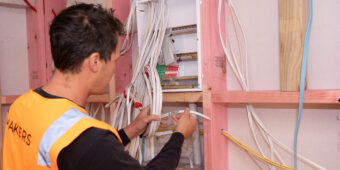How to get the most out of your subbies
14 Apr 2016, Business Tips, Featured, Prove Your Know How

Business coach Graeme Owen asked builders about the problems that can arise when working with substandard electricians; here are some tips to help you sort the wheat from the chaff
To help identify what to look for in subcontractors, I asked a number of builders, as an example: “what’s your number one frustration when dealing with electricians?”
The most common frustrations were:
Leaving a mess
Those surveyed said that subcontractors who don’t pick up after themselves are an issue, because they threaten their reputations running clean and tidy work sites.
Threatening structural integrity
By drilling and cutting into structural elements, a bad electrician can compromise a building’s strength. Examples included incidents where sparkies notched studs and beams rather than centre drilling.
Ruining great finishes
Another common complaint was that they didn’t take care to perform their work to the same standard as finished work.
Examples included drilling through finished aluminium worktops, not fixing switches at the same height, damaging finished walls and smashing holes rather than neatly drilling them.
This led to delays on site, whether it was because of newbies making mistakes or electricians overlooking important fittings in prewire.
It’s not all bad
Some builders surveyed, who’d had complaints in the past, said they now had a great electrical subcontractor on whom they could rely. So what did these builders do to get such a good run?
Here are five things we found that can make a difference:
1. Work with subbies you know
Put a process in place to ensure you only engage the type of subcontractors you want to work with.
Start by doing a reference check. Hiring a subcontractor should be no different to hiring an employee. After all, they can have as big an impact on your reputation as any employee, possibly more so, so getting it right at the beginning is essential.
2. Require accountability
There is an old saying that goes, “you don’t know what you don’t know”.
If you don’t inform a subcontractor about what you want done, then you are destined to get only what they think should be done.
To make expectations clear, create a checklist that outlines what you want your subcontractors and their team to do. Include it with the documents you send when you engage them. You may even require that a completed checklist be included with any invoices.
Ensure that your site supervisor has spare copies of any checklists, so they can check them off at the end of each job. It’s also a good idea to include what type of behaviour you expect on your site and other rules of conduct, such as parking, tidiness, customer communication etc.
By doing this, you’re making it clear that you have a standard of performance you expect them to meet. You might feel this will put some subcontractors off dealing with you, but the good ones won’t mind. They will understand why you’re doing it and, most likely, already be doing it anyway!
3. Plan your schedule
Supplier and subcontractor delays are one of the largest scheduling problems builders face – especially ones that occur on short notice. Finding fill-in work for carpenters is not easy, and almost always eats into profit margins. Consequently, keeping subcontractors on time can have huge financial benefits over the long haul.
When you’re setting up your job schedule, make the start date for subcontractors as early as possible. This way you create a buffer in case there are any delays. Where appropriate, schedule carpentry to coincide with when the subcontractor is on site. Then, if your subcontractor is delayed, there is less impact on your time schedule.
4. Regular updates
Just as you plan work targets with your employees, do the same with your subcontractors. Call them regularly (even daily) and ask them about their target for the next day/week. Ask about any problems they foresee or are having and how they will solve these to stay on schedule. Get agreement so that everyone is on the same page, then follow up.
By doing so, you not only have a better chance of keeping your job on schedule but, in some cases, you may help your subcontractors improve their performance and possibly even their profits. That has to be good for everyone.
5. No excuses!
Great subcontractors and great builders take responsibility. Make it clear that there are no excuses and that simply laying blame isn’t an option. When something doesn’t go to plan, you need to know that your subcontractor is committed to fixing it. Expect them to inform you immediately if a problem arises and to outline how they will remedy it.
It’s when these stressful occasions occur that clear expectations and accountability illuminate the way forward. Moreover, when these situations are handled professionally, strong relationships and loyalties are built.
Stick to the above and you will attract the subcontractors you want to work with – and those who will want to work with you. The result will be a strong network of subcontractors you can rely on.
Graeme Owen, based in Auckland, is a builders’ business coach. Since 2006, he has helped builders get off the tools, make decent money, and free up time for family, fishing, and enjoying sports. www.thesuccessfulbuilder.com
Register to earn LBP Points Sign in



